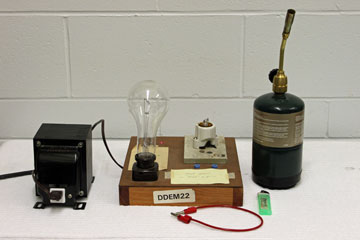Objective:
– To demonstrate that glass will conduct electricity at high temperature.
Apparatus:
- Glass conduction apparatus, c/w:
- 250 watt lamp, ceramic “melting socket,” line cord
- Propane torch
- Glass element carefully prepared and pre-tested
- Isolation transformer

Method:
The series circuit containing the glass element and lamp bulb is open-circuited at room temperature. If the element is heated on one flat side to melting point, then due to the high negative resistance — temperature coefficient of glass, the conductivity increases rapidly, and at a bright red heat the P=I2R loss in the glass is sufficient to maintain the temperature without further use of the flame.
Note:
-
- Ensure that the A.C. switch on the conduction apparatus is on.
- Heat the glass element on the flat side of the glass mount/stem only. Otherwise, the sagging molten glass may collapse, causing the internal conductors to short together.
- Please wear gloves when handling hot bulbs.
- Remember to replace the shorted light bulb with broken glass shell after each demo.
Electrical Conduction of Glass
– video not produced by BCIT